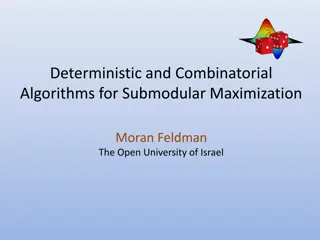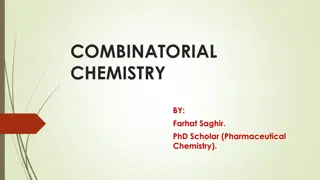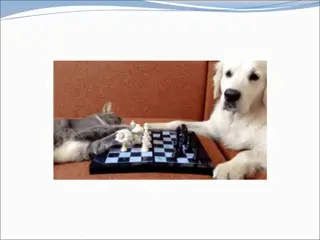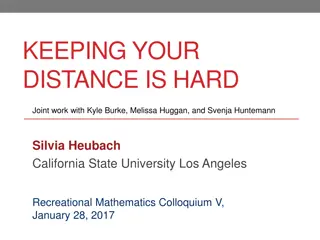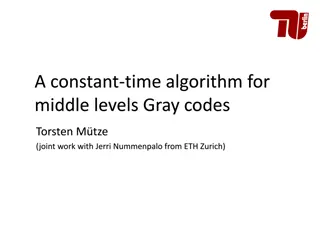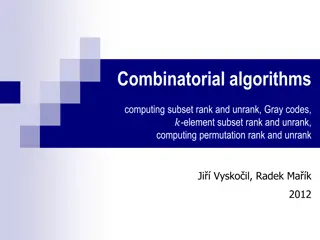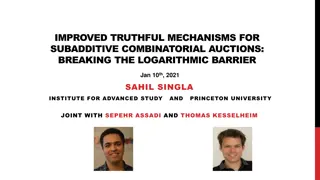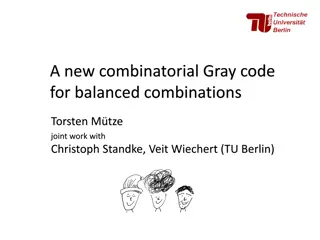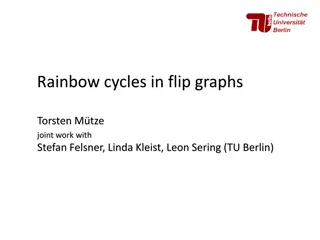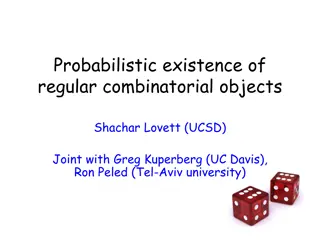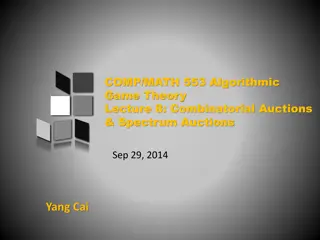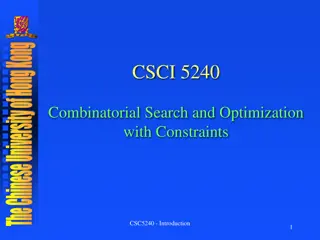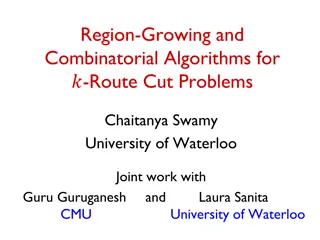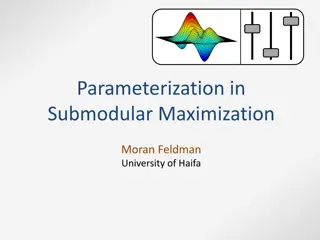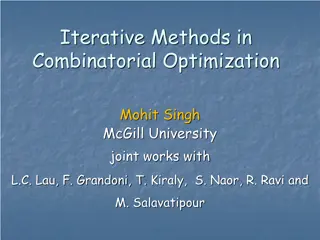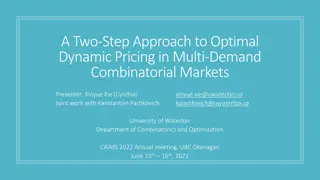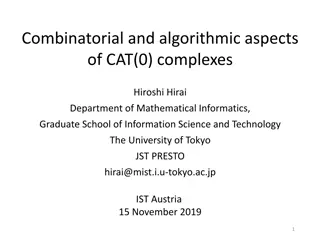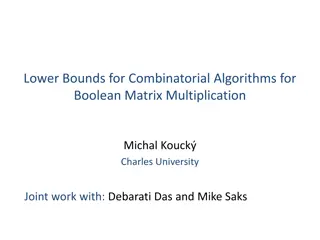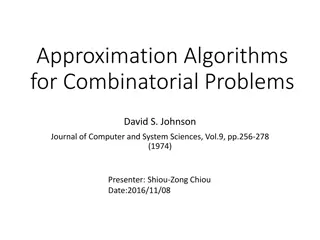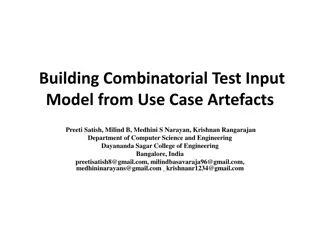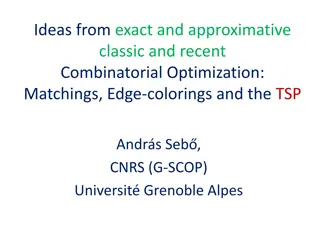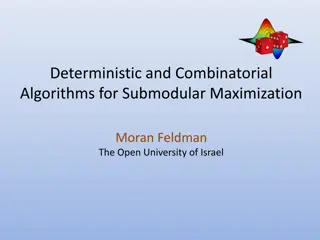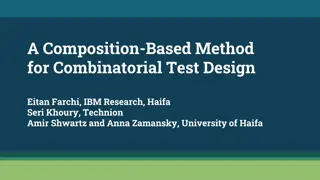Near-Optimal Quantum Algorithms for String Problems - Summary and Insights
Near-Optimal Quantum Algorithms for String Problems by Ce Jin and Shyan Akmal presents groundbreaking research on string problem solutions using quantum algorithms. The study delves into various key topics such as Combinatorial Pattern Matching, Basic String Problems, Quantum Black-box Model, and mo
1 views • 25 slides
Submodular Maximization Algorithms Overview
This article discusses deterministic and combinatorial algorithms for submodular maximization, focusing on their applications in various fields such as combinatorics, machine learning, image processing, and algorithmic game theory. It covers key concepts like submodularity, examples of submodular op
1 views • 25 slides
Combinatorial Chemistry in Pharmaceutical Research
Combinatorial chemistry is a powerful method in drug discovery allowing for the synthesis of a large number of compounds simultaneously. This process helps in lead identification and optimization, enabling the screening of diverse compound libraries for potential biological activity. Various design
0 views • 42 slides
Overview of DARE22 Test Vehicle Design on FD SOI 22nm Process
This detailed presentation explores the test structures and components inside the TV, including combinatorial logic, sequential logic, clock gating, ring oscillators, input-output cells, analog IPs, and more. It covers various test scenarios such as irradiation testing, SET/SEU measurements, functio
1 views • 32 slides
Discrepancy Minimization in Combinatorial Concepts
Explore the intriguing world of Discrepancy Minimization through concepts like walking on the edges, subsets coloring, arithmetic progressions, and more. Delve into fundamental combinatorial concepts and complexity theory to understand the significance of Discrepancy theory in various fields. Discov
0 views • 33 slides
Solving Combinatorial Problems: Dice Rolls, 8 Queens, and Chess Board Exploration
Implement methods for rolling dice with a specified sum, solving the 8 Queens problem, and exploring chess board configurations. Utilize different algorithms and decision-making processes to tackle these combinatorial challenges effectively.
1 views • 8 slides
Deciphering Combinatorial Games Through Mathematical Analysis
Discover the intricacies of combinatorial games by analyzing strategies for winning and understanding the dynamics of distance games on graphs. Learn about known distance games like COL, SNORT, and NODEKAYLES, and explore techniques such as strategy stealing and mirroring to determine optimal gamepl
0 views • 22 slides
Middle Levels Gray Codes: Loopless Generation Algorithms and Conjecture
Combinatorial Gray codes involve generating combinatorial objects with minimal differences between consecutive objects. The Middle Levels Conjecture focuses on cyclically generating ground set subsets with specific characteristics. This conjecture has led to significant theoretical and experimental
0 views • 15 slides
Combinatorial Algorithms for Subset and Permutation Ranking
Combinatorial algorithms play a crucial role in computing subset and permutation rankings. These algorithms involve defining ranking functions, successor functions, lexicographic ordering on subsets, and permutation representations. The functions SUBSETLEXRANK and SUBSETLEXUNRANK are used for comput
1 views • 22 slides
S32K3 Real-Time Development Training Overview
Explore the S32K3 Real-Time Development (RTD) training for Logic Control Unit (LCU) in automotive applications. Learn about LCU configuration, main API functions, example codes, Look-Up Table (LUT) setup, and tips for optimal usage. Discover how LCU interacts with combinatorial logic, latches, and a
1 views • 22 slides
Improved Truthful Mechanisms for Subadditive Combinatorial Auctions
This research paper discusses strategies to maximize welfare in combinatorial auctions. It explores mechanisms for handling strategic bidders with private valuations, aiming to design truthful and optimal welfare mechanisms while considering polytime constraints. The study presents advancements in a
0 views • 19 slides
Insights into NP-Hard Problems in Molecular Biology and Genetics
Understanding the complexity of NP-Hard Problems arising in molecular biology and genetics is crucial. These problems involve genome sequencing, global alignment of multiple genomes, identifying relations through genome comparison, discovering dysregulated pathways in human diseases, and finding spe
0 views • 24 slides
A New Combinatorial Gray Code for Balanced Combinations
This research work by Torsten Mütze, Christoph Standke, and Veit Wiechert introduces a new combinatorial Gray code for balanced combinations, focusing on a-element subsets and flaws in Dyck path representation. The study explores various aspects of balanced combinations, their flaws, and the relati
1 views • 30 slides
Rectangular Dissections and Edge-Flip Chains in Lattice Triangulations
Explore equitable rectangular dissections and their applications in VLSI layout, graph mapping, and combinatorial problems in this scholarly work by Dana Randall from Georgia Institute of Technology. Discover the concept of partitioning an n x n lattice region into n2/a rectangles or areas where cor
1 views • 32 slides
Combinatorial Optimization in Integer Programming and Set-Cover Problems
Explore various combinatorial optimization problems such as Integer Programming, TSP, Knapsack, Set-Cover, and more. Understand concepts like 3-Dimensional Matching, SAT, and how Greedy Algorithms play a role. Delve into NP-Hard problems like Set-Cover and analyze the outcomes of Greedy Algorithm se
0 views • 60 slides
Rainbow Cycles in Flip Graphs and Associahedra: Combinatorial Study
Exploring rainbow cycles and associated properties in the context of flip graphs and triangulations, this study delves into the diameter, realiability, automorphism group, and more of the associahedron. Motivated by binary reflected Gray codes, the research aims to find balanced Gray codes for vario
0 views • 23 slides
Probabilistic Existence of Regular Combinatorial Objects
Shachar Lovett from UCSD, along with Greg Kuperberg from UC Davis, and Ron Peled from Tel-Aviv University, explore the probabilistic existence of regular combinatorial objects like regular graphs, hyper-graphs, and k-wise permutations. They introduce novel probabilistic approaches to prove the exist
0 views • 46 slides
Combinatorial Counting and Algorithm Design Concepts
Today's lecture covers the basics of combinatorial counting and its applications in algorithm analysis. Topics include exhaustive search strategies, determining graph properties, and various counting techniques. Techniques such as counting objects and generating subsets are discussed, along with alg
0 views • 20 slides
Algorithmic Game Theory: VCG Mechanism and Combinatorial Auctions
Delve into the intricate world of Algorithmic Game Theory as we explore the Vickrey-Clarke-Groves (VCG) Mechanism and its applications in Combinatorial Auctions. Understand the principles behind maximizing social welfare, allocation rules, and payment mechanisms with real-world case studies. Explore
0 views • 26 slides
Combinatorial Interaction Testing for Automated Constraint Repair
In this study presented at IWCT2017, Angelo Gargantini discusses a novel automated approach for finding and fixing conformance faults in software systems using combinatorial models. The goal is to discover and repair faults in the constraints of the model, assuming faults lie in the model and not th
0 views • 4 slides
Optimal Bundle Selection in Combinatorial Voting
This work explores optimal bundle selection in combinatorial voting scenarios, focusing on satisfying user preferences and applying Condorcet criteria and related voting rules for effective decision-making.
0 views • 17 slides
Algorithmic Game Theory: Combinatorial & Spectrum Auctions Overview
This content delves into the VCG mechanism, combinatorial auctions, and spectrum auctions in Algorithmic Game Theory. It discusses maximizing social welfare, practical challenges, and implications for real-world scenarios like spectrum allocation. The VCG mechanism and its role in optimizing social
0 views • 23 slides
Network Coding Impact on Combinatorial Optimization
Explore the impact of network coding on combinatorial optimization, highlighting its benefits, applications, and algorithms. Discover the advantages of network coding over routing, algebraic algorithms for connectivity, and various scenarios where network coding excels. Dive into the significance of
0 views • 68 slides
Combinatorial Search and Optimization at The Chinese University of Hong Kong
Explore CSCI 5240 at The Chinese University of Hong Kong, including modules, workshops, assignments, and blended learning approach. Enhance your skills in combinatorial search and optimization with constraints. Get insights into MOOCs, administrative details, and tasks to complete. Join this educati
0 views • 8 slides
Cut Problems in Network Design: Region Growing and Combinatorial Algorithms
Explore the challenges and solutions of multicut problems in network design using region-growing and combinatorial algorithms. Learn about different types of cuts, feasible solutions, and the complexity of multicut and multiway cut problems. Discover the significance of ?-route cuts in enhancing net
0 views • 23 slides
Submodular Maximization and Combinatorial Optimization Insights
Discover the realm of submodular maximization and combinatorial optimization through concepts such as maximum matching, Max-SAT, and interesting special cases. Understand the significance of submodularity in various fields, from economics to sensor covering. Dive into why submodular functions matter
0 views • 30 slides
Iterative Methods in Combinatorial Optimization: Overview and Results
Explore the world of Combinatorial Optimization through iterative methods, linear programming, and rounding techniques. Learn about Minimum Bounded Degree Spanning Tree (MBDST) problem and how iterative rounding and relaxation play a crucial role in solving complex optimization problems efficiently.
0 views • 39 slides
Efficient Thin Film Design Refinement and Parallel Combinatorial Search
Explore the efficient design refinement of thin films through parallel combinatorial search techniques. Discover the merit functions, combinatorial search concepts, and implementation efficiency for AR coating design. Witness the results of the 14-layer AR coating on a substrate, optimizing reflecti
0 views • 8 slides
ECE 2060 Lab 1: Combinatorial Logic Exploration
Explore combinatorial logic with ECE 2060 Lab 1. Construct AND and XOR gates, simulate with ModelSim, and delve into VHDL coding. Get hands-on experience in digital design.
0 views • 5 slides
Optimal Dynamic Pricing in Multi-Demand Combinatorial Markets
Explore a two-step approach to optimal dynamic pricing in multi-demand combinatorial markets, aiming to maximize social welfare and buyer utility through strategic pricing strategies. Learn about the principles, goals, and challenges in dynamic pricing within complex market structures.
0 views • 18 slides
Algorithmic and Combinatorial Aspects of CAT(0) Complexes
Delve into the fascinating world of CAT(0) complexes with insights on combinatorial and algorithmic aspects, exploring geodesic metric spaces, phylogenetic trees, and the unique properties of CAT(0)-spaces. Discover how researchers like Hiroshi Hirai are unraveling the mysteries of these intriguing
0 views • 30 slides
Prophet Secretary for Combinatorial Auctions and Matroids
Learn about the Prophet Secretary problem in online decision making, the Secretary Problem, Prophet Inequalities, and a simple tight algorithm. Discover the contributions and advancements in Prophet Inequality for settings like matroids and combinatorial auctions.
1 views • 14 slides
Bounds for Combinatorial Algorithms in Boolean Matrix Multiplication
Explore lower bounds for combinatorial algorithms in Boolean matrix multiplication, discussing techniques, methodologies, and results from joint research work. Understand the importance of combinatorial algorithms and their applications.
0 views • 18 slides
Introduction to Computational Geometry: Line Arrangements and Discrepancy Problems
Explore the complexity and construction of line arrangements, discrepancy problems, and the reduction to point problems in computational geometry. Learn about geometric structures, combinatorial complexity, and the exact size of simple arrangements.
0 views • 29 slides
Analysis of Approximation Algorithms for Combinatorial Problems
In this study, heuristic algorithms for approximate solutions to polynomial complete optimization problems are examined, evaluating their worst-case behavior and performance compared to optimal solutions. Various combinatorial problems such as the knapsack problem, set covering problems, and finding
0 views • 32 slides
Combinatorial Test Design Model in Software Development
Explore the process of deriving a Combinatorial Test Design Model from use case artefacts and specifications in software testing. Learn about the steps involved and the importance of automation in this area.
0 views • 30 slides
Innovations in Combinatorial Optimization: Matchings, Edge-colorings, TSP
Explore cutting-edge research in combinatorial optimization focusing on matchings, edge-colorings, and the Traveling Salesman Problem (TSP) including classic and recent advancements in the field.
0 views • 25 slides
Deterministic and Combinatorial Algorithms for Submodular Maximization
Explore deterministic and combinatorial algorithms for submodular maximization with examples like Max DiCut and Max k-Cover. Learn about submodular optimization and continuous relaxations in various applications such as combinatorics, machine learning, and image processing.
0 views • 25 slides
Composition-Based Combinatorial Test Design Method
Explore a composition-based method for combinatorial test design in Unix shell commands, featuring examples of ls, grep, and their composition. Learn about the main contributions and the distinction between input and output in test plans. Discover how to formulate and solve a composition-oriented CT
0 views • 19 slides
Effective Combinatorial Testing for Data Mining Algorithms
Explore the effectiveness of applying combinatorial testing to data mining algorithms through experimental design, research questions, subject programs, datasets, test generation, metrics, and results analysis. Discover the impact of different datasets on test coverage and the correlation between br
0 views • 26 slides

